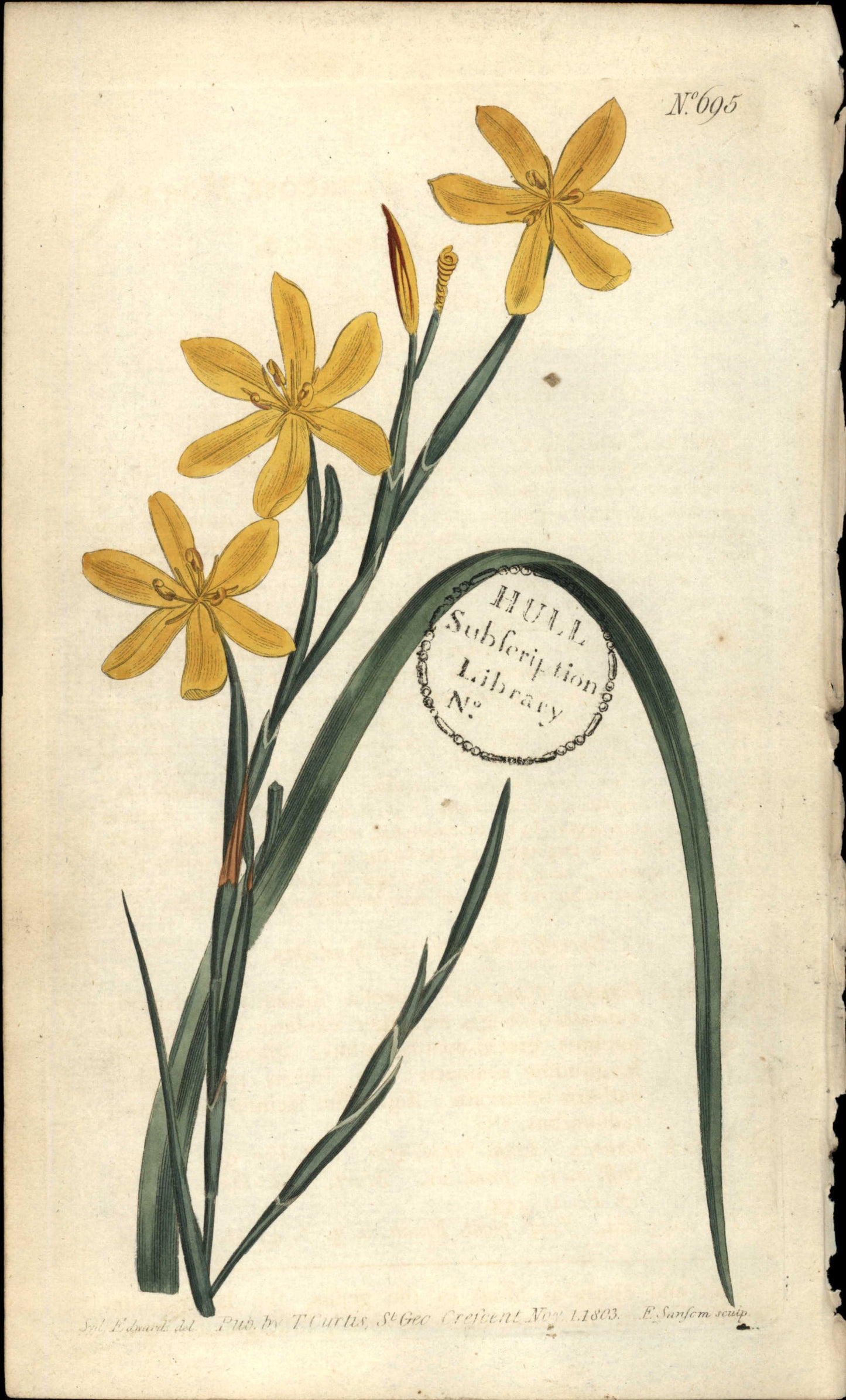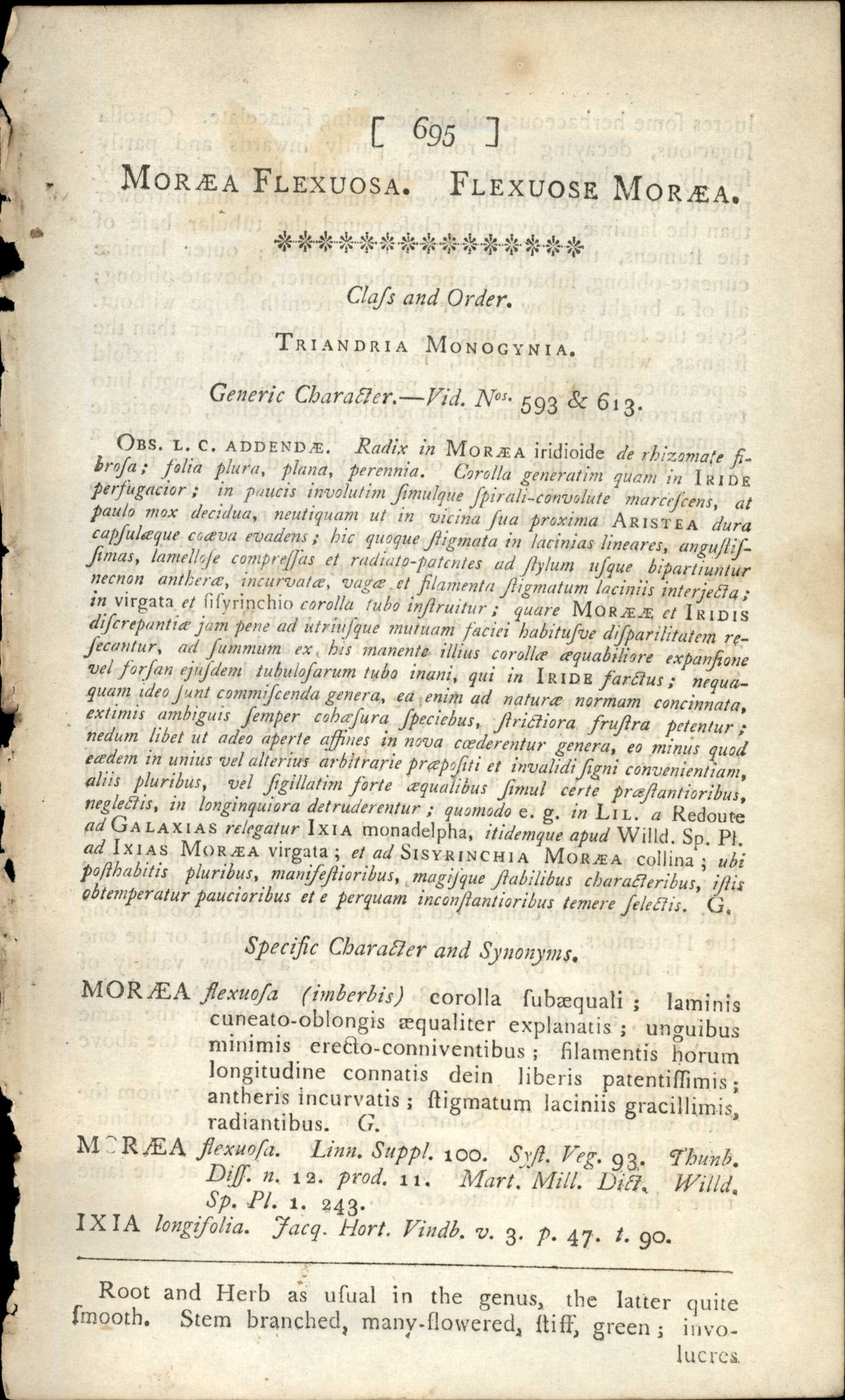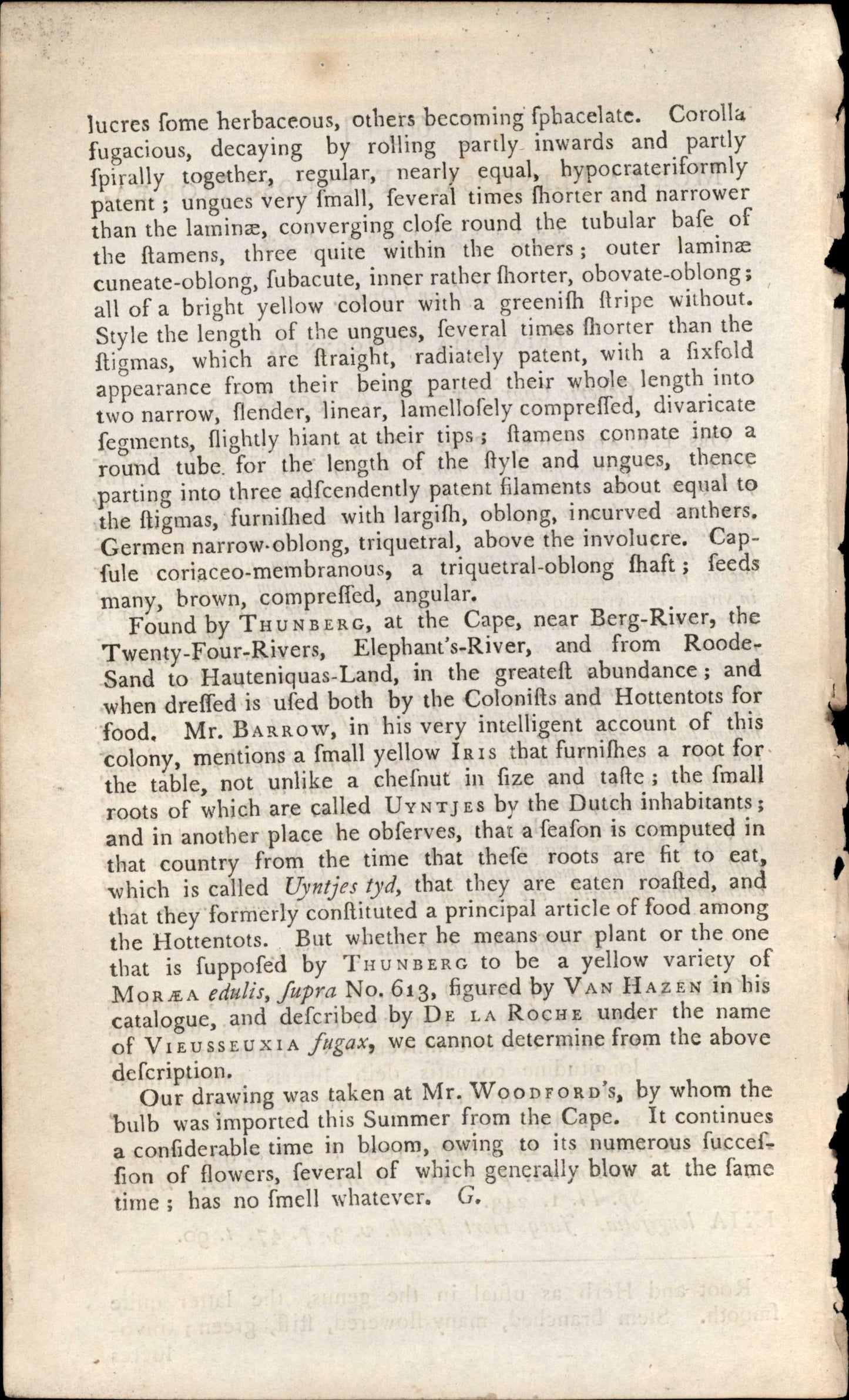Curtis Botanical Magazine
Plate 695 - Flexuose Morea
Plate 695 - Flexuose Morea
Couldn't load pickup availability
Plate 695
Publication Date: Nov 1.1803
Complete Botanical Text (Cleaned)
N°695 HULL subscription Library N: Sul, Edwards del Pub. by TCurtis, st Geo Crefcent No. 1.1803.
E.
Sanfem scuip alloon bon[695] bas biswi y [695] demol azobl MOREA FLEXUOSA.
FLEXUOSE MOREA. ************** gooldo-bisvodo uod Tw dinos Class and Order. orlanadi blowh od) neds antomeil adr guoldo-51 idgid s lo lle digos! TRIANDRIA MONOGYNIA. asing it dairw midge Generic Character.-Vid.
Nos. 593 & 613. 16 VOTIS OW OBS.
L.
C.
ADDENDE.
Radix in MOREA iridioide de rhizomate fi- brofa; solia plura, plana, perennia.
Corolla generatim quam in IRIDE perfugacior; in paucis involutim fimulque fpirali-convolute marcefcens, at paulo mox decidua, neutiquam ut in vicina fua proxima ARIsTEA dura capfulaque coava evadens; hic quoque stigmata in lacinias lineares, anguftif- fimas, lamellofe compreffas et radiato-patentes ad ftylum usque bipartiuntur necnon antheræ, incurvata, vaga et filamenta stigmatum laciniis interjecta; in virgata et fifyrinchio corolla tubo inftruitur; quare MOREE et IRIDIS difcrepantia jam pene ad utriusque mutuam faciei habitufve difparilitatem re- fecantur, ad fummum ex his manente illius corollæ æquabiliore expanfione vel forfan ejufdem tubulofarum tubo inani, qui in IRIDE farctus; nequa- quam ideo sunt commifcenda genera, ea enim ad natura normam concinnata, extimis ambiguis semper cobafura speciebus, ftrictiora fruftra petentur; nedum libet ut adeo aperte affines in nova coederentur genera, eo minus quod eædem in unius vel alterius arbitrarie præpofiti et invalidi figni convenientiam, aliis pluribus, vel figillatim forte æqualibus fimul certe præftantioribus, neglectis, in longinquiora detruderentur; quomodo e. g. in LIL. a Redoute ad GALAXIAS relegatur IXIA monadelpha, itidemque apud Willd. sp.
Pl. ad IXIAS MOREA virgata; et ad SIsYRINCHIA MOREA collina ; ubi pofthabitis pluribus, manifeftioribus, magifque ftabilibus characteribus, iftis obtemperatur paucioribus et e perquam inconstantioribus temere felectis.
G. specific Character and synonyms. 21010 Ev wolls MOREA flexuosa (imberbis) corolla fubæquali ; laminis cuneato-oblongis æqualiter explanatis; unguibus ovode sa minimis erecto-conniventibus; filamentis horum longitudine connatis dein liberis patentissimis ; so modantheris incurvatis ; stigmatum laciniis gracillimis, undingo radiantibus.
G.
MOREA flexuosa.
Linn.
Suppl. 100. syst.
Veg. 93.
Thunb. omel oils Diff. n. 12. prod. 11.
Mart.
Mill.
Dict, Willd, sp.
Pl. 1. 243.
IXIA longisolia.
Jacq.
Hort.
Vindb. v. 3. p. 47. t. 9o.
Root and Herb as usual in the genus, the latter quite smooth. stem branched, many-flowered, ftiff, green; invo- lucres lucres some herbaceous, others becoming fphacelate.
Corolla fugacious, decaying by rolling partly inwards and partly fpirally together, regular, nearly equal, hypocrateriformly patent; ungues very fmall, several times shorter and narrower than the lamina, converging close round the tubular base of the stamens, three quite within the others; outer laminæ cuneate-oblong, fubacute, inner rather shorter, obovate-oblong; all of a bright yellow colour with a greenifh ftripe without. style the length of the ungues, several times shorter than the stigmas, which are straight, radiately patent, with a sixsold appearance from their being parted their whole length into two narrow, flender, linear, lamellofely compressed, divaricate segments, slightly hiant at their tips; stamens connate into a round tube. for the length of the ftyle and ungues, thence parting into three adfcendently patent filaments about equal to the stigmas, furnished with largifh, oblong, incurved anthers.
Germen narrow-oblong, triquetral, above the involucre.
Cap- fule coriaceo-membranous, a triquetral-oblong fhaft; seeds many, brown, compressed, angular.
Found by THUNBERG, at the Cape, near Berg-River, the Twenty-Four-Rivers, Elephant's-River, and from Roode- Sand to Hauteniquas-Land, in the greateft abundance; and when dreffed is ufed both by the Colonifts and Hottentots for sood.
Mr.
BARROW, in his very intelligent account of this colony, mentions a fmall yellow IRIS that furnishes a root for the table, not unlike a chefnut in size and tafte; the fmall roots of which are called UYNTJES by the Dutch inhabitants; and in another place he obferves, that a feason is computed in that country from the time that these roots are fit to eat, which is called Uyntjes tyd, that they are eaten roafted, and that they formerly conftituted a principal article of sood among the Hottentots.
But whether he means our plant or the one that is supposed by THUNBERG to be a yellow variety of MOREA edulis, supra No. 613, figured by VAN HAZEN in his catalogue, and described by DE LA ROCHE under the name of VIEUsSEUXIA fugax, we cannot determine from the above description.
Our drawing was taken at Mr.
WOODFORD's, by whom the bulb was imported this Summer from the Cape.
It continues a considerable time in bloom, owing to its numerous fuccef- fion of flowers, several of which generally blow at the same time; has no fmell whatever.
G.
U ATZI and saunan or ni laulu ze dish bas 106 Bill beswollensm bodomand moe .diogal
Raw OCR Text (Original)
N°695 HULL subscription Library N: Sul, Edwards del Pub. by TCurtis, st Geo Crefcent No. 1.1803. E. Sanfem scuip alloon bon[695] bas biswi y [695] demol azobl MOREA FLEXUOSA. FLEXUOSE MOREA. ************** gooldo-bisvodo uod Tw dinos Class and Order. orlanadi blowh od) neds antomeil adr guoldo-51 idgid s lo lle digos! TRIANDRIA MONOGYNIA. asing it dairw midge Generic Character.-Vid. Nos. 593 & 613. 16 VOTIS OW OBS. L. C. ADDENDE. Radix in MOREA iridioide de rhizomate fi- brofa; solia plura, plana, perennia. Corolla generatim quam in IRIDE perfugacior; in paucis involutim fimulque fpirali-convolute marcefcens, at paulo mox decidua, neutiquam ut in vicina fua proxima ARIsTEA dura capfulaque coava evadens; hic quoque stigmata in lacinias lineares, anguftif- fimas, lamellofe compreffas et radiato-patentes ad ftylum usque bipartiuntur necnon antheræ, incurvata, vaga et filamenta stigmatum laciniis interjecta; in virgata et fifyrinchio corolla tubo inftruitur; quare MOREE et IRIDIS difcrepantia jam pene ad utriusque mutuam faciei habitufve difparilitatem re- fecantur, ad fummum ex his manente illius corollæ æquabiliore expanfione vel forfan ejufdem tubulofarum tubo inani, qui in IRIDE farctus; nequa- quam ideo sunt commifcenda genera, ea enim ad natura normam concinnata, extimis ambiguis semper cobafura speciebus, ftrictiora fruftra petentur; nedum libet ut adeo aperte affines in nova coederentur genera, eo minus quod eædem in unius vel alterius arbitrarie præpofiti et invalidi figni convenientiam, aliis pluribus, vel figillatim forte æqualibus fimul certe præftantioribus, neglectis, in longinquiora detruderentur; quomodo e. g. in LIL. a Redoute ad GALAXIAS relegatur IXIA monadelpha, itidemque apud Willd. sp. Pl. ad IXIAS MOREA virgata; et ad SIsYRINCHIA MOREA collina ; ubi pofthabitis pluribus, manifeftioribus, magifque ftabilibus characteribus, iftis obtemperatur paucioribus et e perquam inconstantioribus temere felectis. G. specific Character and synonyms. 21010 Ev wolls MOREA flexuosa (imberbis) corolla fubæquali ; laminis cuneato-oblongis æqualiter explanatis; unguibus ovode sa minimis erecto-conniventibus; filamentis horum longitudine connatis dein liberis patentissimis ; so modantheris incurvatis ; stigmatum laciniis gracillimis, undingo radiantibus. G. MOREA flexuosa. Linn. Suppl. 100. syst. Veg. 93. Thunb. omel oils Diff. n. 12. prod. 11. Mart. Mill. Dict, Willd, sp. Pl. 1. 243. IXIA longisolia. Jacq. Hort. Vindb. v. 3. p. 47. t. 9o. Root and Herb as usual in the genus, the latter quite smooth. stem branched, many-flowered, ftiff, green; invo- lucres. lucres some herbaceous, others becoming fphacelate. Corolla fugacious, decaying by rolling partly inwards and partly fpirally together, regular, nearly equal, hypocrateriformly patent; ungues very fmall, several times shorter and narrower than the lamina, converging close round the tubular base of the stamens, three quite within the others; outer laminæ cuneate-oblong, fubacute, inner rather shorter, obovate-oblong; all of a bright yellow colour with a greenifh ftripe without. style the length of the ungues, several times shorter than the stigmas, which are straight, radiately patent, with a sixsold appearance from their being parted their whole length into two narrow, flender, linear, lamellofely compressed, divaricate segments, slightly hiant at their tips; stamens connate into a round tube. for the length of the ftyle and ungues, thence parting into three adfcendently patent filaments about equal to the stigmas, furnished with largifh, oblong, incurved anthers. Germen narrow-oblong, triquetral, above the involucre. Cap- fule coriaceo-membranous, a triquetral-oblong fhaft; seeds many, brown, compressed, angular. Found by THUNBERG, at the Cape, near Berg-River, the Twenty-Four-Rivers, Elephant's-River, and from Roode- Sand to Hauteniquas-Land, in the greateft abundance; and when dreffed is ufed both by the Colonifts and Hottentots for sood. Mr. BARROW, in his very intelligent account of this colony, mentions a fmall yellow IRIS that furnishes a root for the table, not unlike a chefnut in size and tafte; the fmall roots of which are called UYNTJES by the Dutch inhabitants; and in another place he obferves, that a feason is computed in that country from the time that these roots are fit to eat, which is called Uyntjes tyd, that they are eaten roafted, and that they formerly conftituted a principal article of sood among the Hottentots. But whether he means our plant or the one that is supposed by THUNBERG to be a yellow variety of MOREA edulis, supra No. 613, figured by VAN HAZEN in his catalogue, and described by DE LA ROCHE under the name of VIEUsSEUXIA fugax, we cannot determine from the above description. Our drawing was taken at Mr. WOODFORD's, by whom the bulb was imported this Summer from the Cape. It continues a considerable time in bloom, owing to its numerous fuccef- fion of flowers, several of which generally blow at the same time; has no fmell whatever. G. U ATZI and saunan or ni laulu ze dish bas 106 Bill beswollensm bodomand moe .diogal
Original botanical print from Curtis's Botanical Magazine
Share







